The Saxons’ Land, or the Royal Domain (Fundus Regius)
The German settlers started to come in the 12th century. The Golden Bull (or Charter) from king András II. from 1224 mentions that the first of them came in the time of king Géza II., that is around 1150. They were invited, got exemption from serfdom and other duties towards the king, and received vast administrative autonomy.
Almost none of the German settlers came from Saxony. The exact origin of most of the settlers in the 12th and 13th century is unknown, but opinions coincide that they came from all over the German-speaking territory. Some of the settlers even were of French or Flemish origin. It is certain that many of them came from the Rhine and Mosel and introduced wine growing to the region where they settled, in the Southeast of Transylvania.
The building style of the older settlements is similiar to that of Frankonia, and their dialect is closest to the one spoken in Luxemburg.
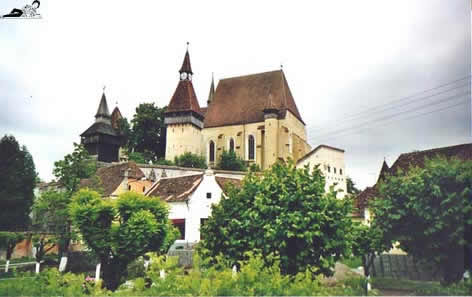 |
The church-fortress of Birthälm (Biertan).
These fortified churches, often situated on a hill, are a special feature of the Transylvanian-Saxonian villages. In times of turmoil the villagers fled to the church and defended themselves from inside. |
The term "Saxon" was applied to them because the first German settlers who came to the Hungarian kingdom were miners from Saxony, who brought with them the "know-how" to start the mining industry in nowadays Slovakia, then Northern Hungary. They were given the privileges that later came to be a status, so "Saxon" did not any longer denominate the origin of someone, but the legal status he enjoyed in medieval Hungary.
In 1211 king András II. – influenced by his German wife, Gertrud, – called the Teutonic Knights’ Order – who was forced out of the Cruisaders’ states in near East by the Muslim re-conquest – to settle in Transylvania, in an area called the "Burzenland" (Ţara Bîrsei), near nowadays Braşov. They were given the right to build fortresses (in these times the privilege of the king), and conquer territories on the other side of the Carpathians, thus pushing the borders of the lands of the Hungarian Crown further to the East.
The Teutonic Knights’ Order was expelled by a Hungarian army only 14 years later, for a number of reasons. The main reason was that the anti-German party in the Hungarian king’s environment had won, his wife got killed, and the Teutonic Knights had become too powerful and were resented by the Hungarian nobility, and the clergy.
| The crypt inside the church of Birthälm (Biertan) |
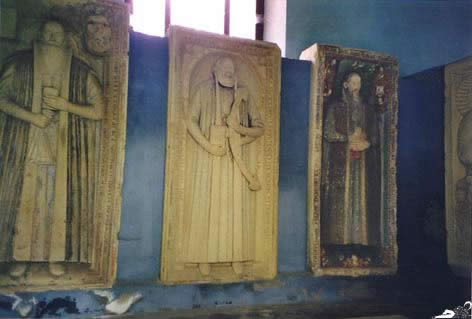 |
In these 14 years they had been in Transylvania, though, they had attracted a lot of settlers that remained after the Teutonic Knights left. They had built some fortresses, some of which fell into oblivion, others gave way to prosperous communities. The most important towns founded by the Teutonic Knights’ Order were Marienburg (Feldioara), Kronstadt (Braşov) and Zeiden (Codlea). They also built Törzburg, the predecessor of nowadys Bran castle (somehow linked to the Dracula stories), securing another one of the Carpathian passes.
Something has to be said about the name that the older settlement areas had: Königsboden – Royal Domain.
The Royal Domain was the land that belonged to the king and which he could donate to settlers, or with which he could enfeoff his followers. This land was the remainder of the "Gyepű", the fallow lands that had surrounded the settled area of the Hungarian tribes. These lands were tribal lands, and they had been left empty, first as a kind of buffer zone against invaders, but also taking into account the time when the tribe would grow and its members would need more land to make a living on.
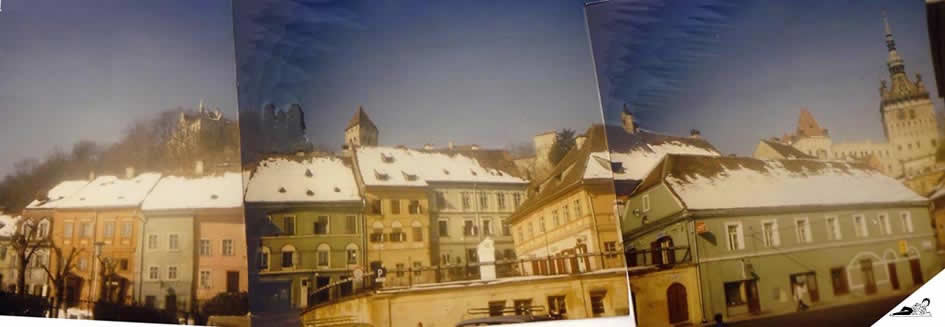
The town of Schässburg (Sigişoara). It is also topped by a church-fortress.
In this town for a while resided the Wallachian Voievod who inspired the Dracula story: Vlad Dracul or Vlad Tepeş ("The Impaler"). Some years ago there were plans by the local and province administrations to build a Dracula-amusement park here, but I believe – luckily – they abstained from it.
When István had himself crowned king in 1000 – overruling and later killing his cousin Koppány, who would have been the legitimate leader of the Hungarian tribal union – he changed the whole system of property: He abolished the tribal property and introduced the feudal property. The vast territories of the Gyepű he declared property of the crown, thus depriving his own subjects of all possibilities of resettling, escaping serfdom and expanding into new areas.
The land that was given to the Germans was therefore land that had been taken away from the Hungarians. In order to attract settlers they were given exemption from serfdom. The arrival of the German settlers was adverse to the fate of the Hungarians, most of all the Szeklers: The Germans were given land, privileges and freedom while the Szeklers suffered a certain setback in these matters. This caused a rivalry and mistrust that to a certain extent persisted till the 20th century.
The Germans were given various territorial autonomies in the course of time. As in one document the unity of 7 towns or fortresses is mentioned, together with the surrounding lands, the Germans started to call their new home "Siebenbürgen" – seven fortresses –, a word that later became the German denomination for Transylvania.
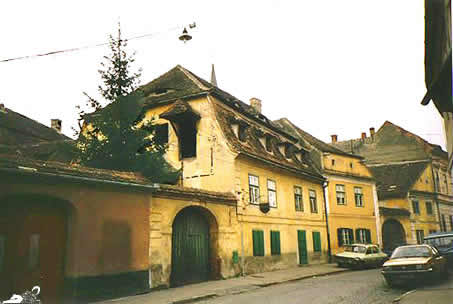 |
A street in the Lower Town of Hermannstadt (Sibiu) |
|
A house in Birthälm (Biertan)
|
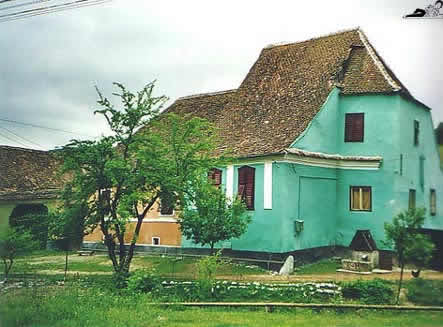 |
After the assault of the Mongolians in 1241 when vast territories in Transylvania had been destroyed, the inhabitants had been killed, or fled, the Hungarian kings intensified their efforts to attract settlers and repopulate the deserted lands. They also took a couple of measures to fortify the Carpathian passes and ravines better against possible new invaders. It was only then that the building of stone fortresses and city walls was not only allowed, but even encouraged, and took place on a large scale.
The town of Hermannstadt (Sibiu) was given the task to secure the Pass of the Red Tower, a ravine that the river Olt has dug himself on his way down to Wallachia. Hermannstadt in the course of time became the biggest and most important town of the Transylvanian Saxons.
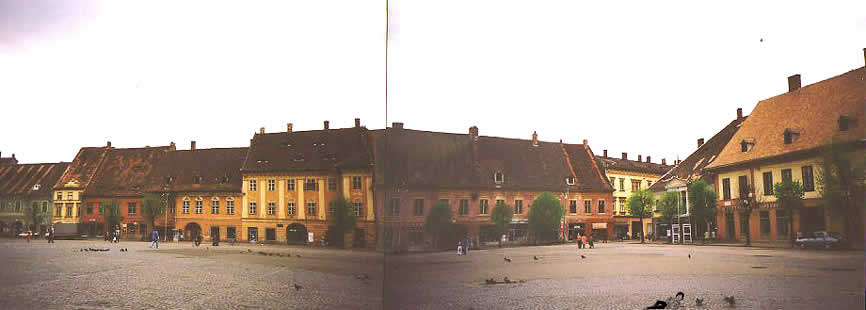
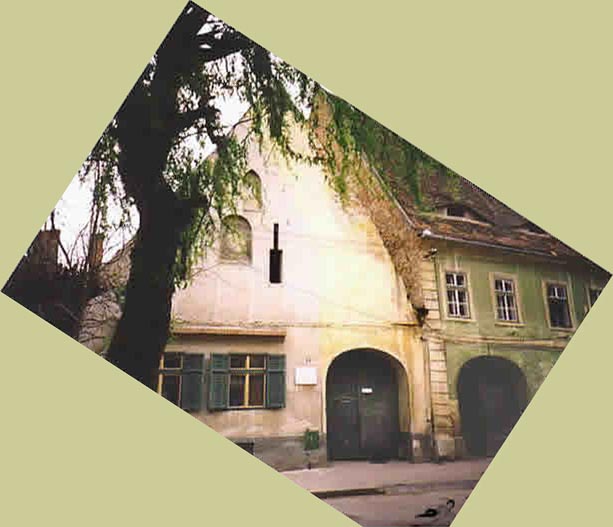 |
The main square in the Upper Town of Hermannstadt
The oldest house (at least the plaque says so) of Hermannstadt, also in the Upper Town
|
The Transylvanian Saxons lived in towns and villages that didn’t form a closed territory of their own, but often were isolated from each other, with land and settlements of other ethnicities between them. The older settlements in the south of Transylvania (Seven Fortresses, Royal Domain) were later followed by other settlements further north, as the towns of Sächsisch-Reen (Reghin) and Bistritz (Bistriţa) that were not connected at all with the older ones.
Some of the communities that the Saxons claim as theirs were neither founded by them, not were they constituting the majority of the population. One should not be confused about this fact just because these settlement had German names, too. Almost all the villages and towns of Transylvania have three names: a Hungarian, a German and a Romanian one .
| The main street in the town of Sächsisch-Reen (Reghin) | 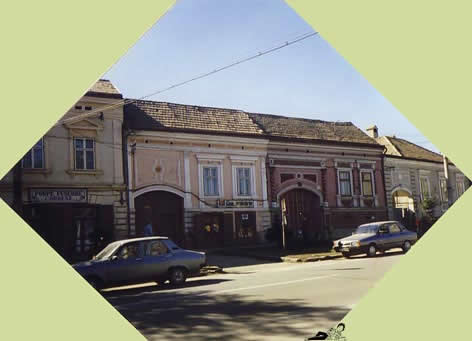 |
The city of Kronstadt (Braşov) was founded on the site of an already existing settlement and the name Braşov is older than the German one. The Hungarian inhabitants of Kronstadt called a part of the town – where the Romanians lived – the "Bulgarian corner", thus suggesting Slavic origins.
The most interesting case is the city of Cluj (in German: Klausenburg, in Hungarian: Kolozsvár) that was built by the Saxons, also on the place of an older settlement, in the 13th century. (It’s origins date back to the Roman times.) Originally it had been one of the towns of the "Seven fortresses". But during the 15th and 16th century it became more and more a Hungarian town. The Saxons of the town showed a strong will to turn Hungarian. King Mátyás (Corvinus) himself – who granted the Saxon autonomy, the "Universitas" – removed Cluj from the Saxon administration and placed it under the jurisdiction of the crown. In the 16th century two reformers of Saxon origin (Heltai and Dávid), but more attached to the Hungarian language, inspired a sectarian-reformist movement that came to form an own protestant church till today existing among the Hungarians, both in Romania as in Hungary: The Unitarians, who reject the idea of Trinity.
In order to preserve their autonomy and privileged situation as town people or free peasants, the Saxons strove for an administrative unity that could be exercised also in remoter areas. They wanted a general representation, autonomous administration and own jurisdiction for all the Transylvanian Saxons and they achieved this finally in 1486. The "Universitas Saxorum", the Saxon Community, lasted until 1876. It formed an entity in the Transylvanian Diet, as one of the "3 Nations", consisting of Hungarians, Szeklers and Saxons.
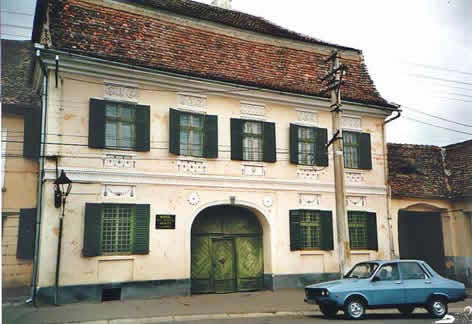 |
A house in Agnetheln (Agnita) |
The printer and scholar Johannes Honterus from Kronstadt introduced Reformation to the Saxons of Transylvania. Due to his influence the Saxons turned Lutherans. Their religion and their autonomous church gave them another bond of unity that persisted after the "Universitas" had been abolished. As the Saxon schools were also run by the church every generation grew up with the self-consciousness to be German-speaking and Lutheran.
The conversion to Lutheranism was smooth and without problems as the principality of Transylvania in the late 16th and the 17th century granted and practiced full liberty of faith in a time when in most of Europe’s countries people were forced to emigrate, to convert, and wars were waged about the religion someone’s subjects wanted to adhere to.
Due to these institutions the Saxons managed to preserve their specific features, but also their isolation. In some way they remained aliens to their environment. Very rarely did they marry outside the Saxon community. They protested successfully for more than a century against the right of Hungarians or Romanians to buy property in their villages and towns.
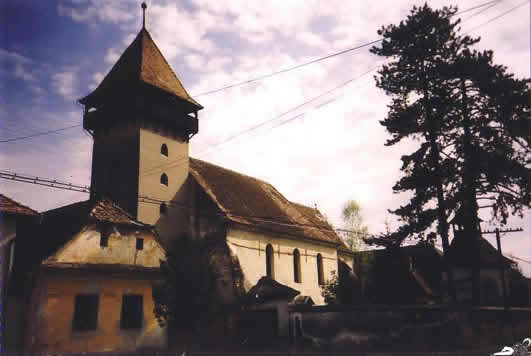 |
Another church-fortress in the village of Dunesdorf (Danes) ...
... and a typical street with Saxon village houses |
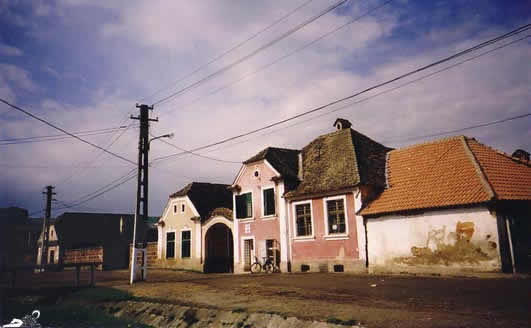 |
After Transylvania became part of Austria the Austrian government deliberately used them for weakening the Hungarian nobility. In the revolution of 1848 they turned against the Hungarian forces. Still this didn’t make them popular neither with the Romanians who (probably rightfully) felt looked at with contempt by them. Nor did they win the support of the Vienna government that felt uncomfortable with them because of their Lutheran faith.
While for centuries they had been a progressive factor in the development of Transylvania, contributing their fair share to urbanization, fortification of the towns, the flourishing of mining, crafts and trade, slowly they began to become a closed community whose main desire was to keep what they had and remain as they were.
In the 19th century they also started to decline in numbers.
Meschenhäuser, a writer from Kronstadt, describes the decades before World War I: A society caught in some kind of stale-mate, entangled in intrigues, with overheated passions, picturing themselves as the last stronghold of civilization and classical education – in an environment that did not care at all about those achievements.
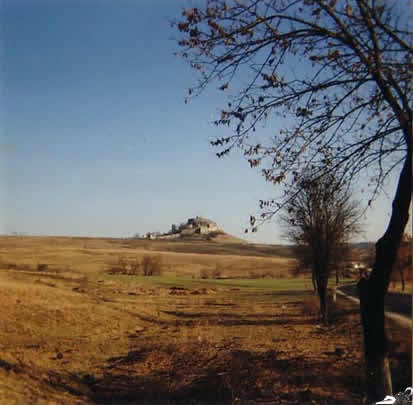 |
A view of the town of Reps (Rupea), showing the castle-quarter on the hill, and parts of the still existing castle walls.
The place for the town was obviously chosen for strategic reasons. |
The disappointment towards Austria which in the end had deprived them of many of their privileges, especially after the "Ausgleich" (a political settlement between the Austrian government and Hungarian politicians, ending a state of 18 years of near-occupation of Hungary) with Hungary in 1867, led them to turn to Germany as their desired and spiritual home. They weren’t proud to be Transylvanian Saxons any more, they didn’t feel that they were part of Austria: they were Germans, stranded in an inhospitable environment.
They isolated themselves even more from their non-German neighbours, started to cultivate German habits and virtues in an almost ridiculous way. Many of them became adherents of Bismarck, and later, of Hitler.
After the Treaty of Trianon the Saxons faced further disadvantages in the new Kingdom of Romania. Though they had been declared "co-existing minorities" by the Romanian National Assembly in Alba Iulia in 1918, in fact they were regarded as privileged strangers with doubtful usefulness for the new state, Romania Mare – Great Romania. Various reforms diminuished their lands, dissolved their institutions and left very little autonomy for them.
| A house in the main square of Mediasch (Mediaş) | 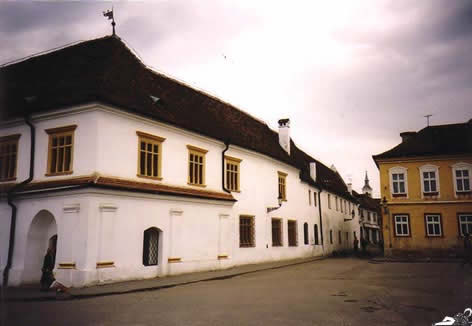 |
The Second Vienna Award that divided Transylvania between Hungary and Romania found them suddenly living in two different states. Germany moreover forced the governments of Romania and Hungary to renounce their German subjects as soldiers. The young men from the "Volksdeutsche" communities, the Transylvanian Saxons and the Swabians from the Banat of Temes and the Hungarian territories were drafted into the German army and the SS. These men later could not return home as they were considered traitors and criminals of war and would have been put on trial, probably executed.
As the war approached to an end and the Romanian army sided with the Red Army the Saxon population of Northern – Hungarian – Transylvania were evacuated on orders from Berlin. The towns of Reghin and Bistriţa and the Saxon villages between and around them – Tekendorf (Teaca), Leschnitz (Lechinţa), and others – from then on ceased to be Saxon. Reghin today is even one of the centers of Romanian chauvinism, the seat of the Vatra Românească.
In Southern – Romanian – Transylvania this did not take place and most of the Saxons remained. Some had also been drafted into the Romanian army, but still many families were torn apart already because of the military service of their men. Then the Soviet troops in all the states they occupied recruited people by force and took them to Soviet Union where they had to help building up the destroyed country. This also affected many of the Transylvanian Saxons.
| One of the guard towers and the yard of the fortified quarter of Mediasch. | 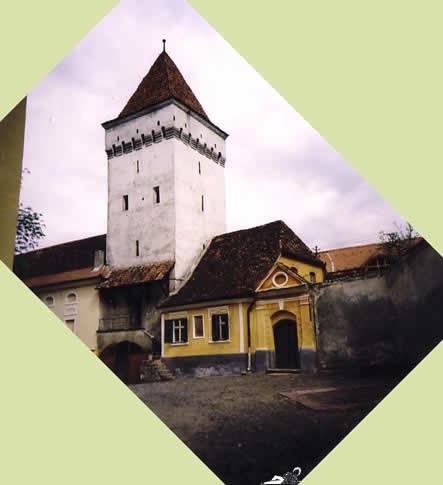 |
All these events and hardships led to a strong desire to emigrate, and a constant stream of Saxons towards Germany. Another chapter in this migration story was opened with the agreement the German chancellor Schmidt and the Romanian president Ceauşescu concluded in 1978. From then on between 10.000 and 20.000 people of German origin (Saxons and Swabians) left Romania for Germany every year till 1989, and Germany payed a certain sum per capita. It kind of bought them.
In the 80-ies the son of Ceauşescu, Nicu, became mayor of Hermannstadt and literally terrorized that town for years, which certainly added to many inhabitants’ desire to get away from there.
After the fall of communism, with the borders more open and an economic situation without perspectives, the remaining Saxons also started to leave.
Nowadays the Saxon towns and villages are mainly populated by Romanians and Gypsies. From the Saxon population some old people remained, and some ministers still performing services in a few of the Lutheran churches, and taking care of the remainders of their community. But lately, as I noticed, things have changed.
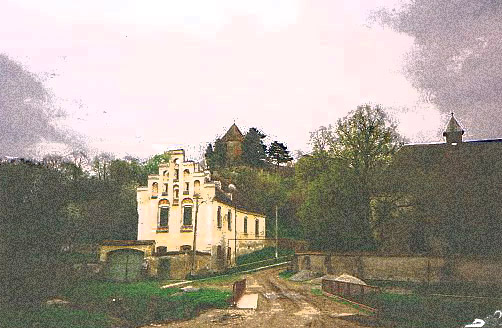 |
The village of Stolzenburg (Slimnic), topped by the ruins of a huge church-fortress, and with this strange building the purpose of which I cannot even guess. |
Emigrants return. They invest, found enterprises, or buy and restore old village houses for holidays. Herrmannstadt, the culture capital of Europe in 2007, is booming. It has a Saxonian mayor and a lot of reviews in German appear there.
| The church-fortress of Heltau (Cisnadie) | 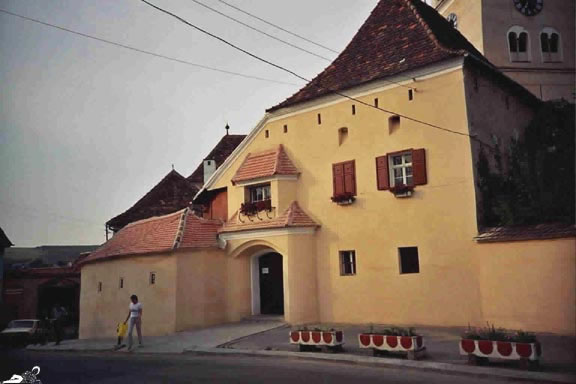 |
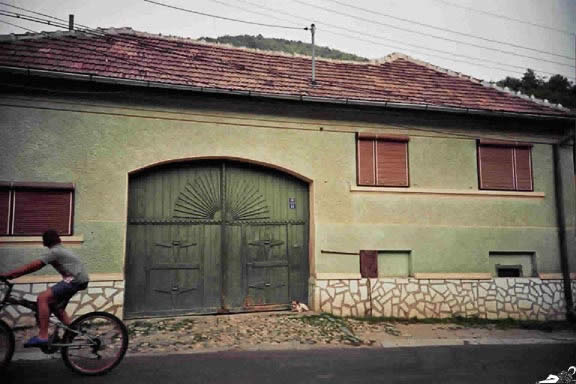 |
and a house in Zoodt (Sadu),
– villages near Herrmannstadt. |
For this page I found useful information on: www.sibiweb.de